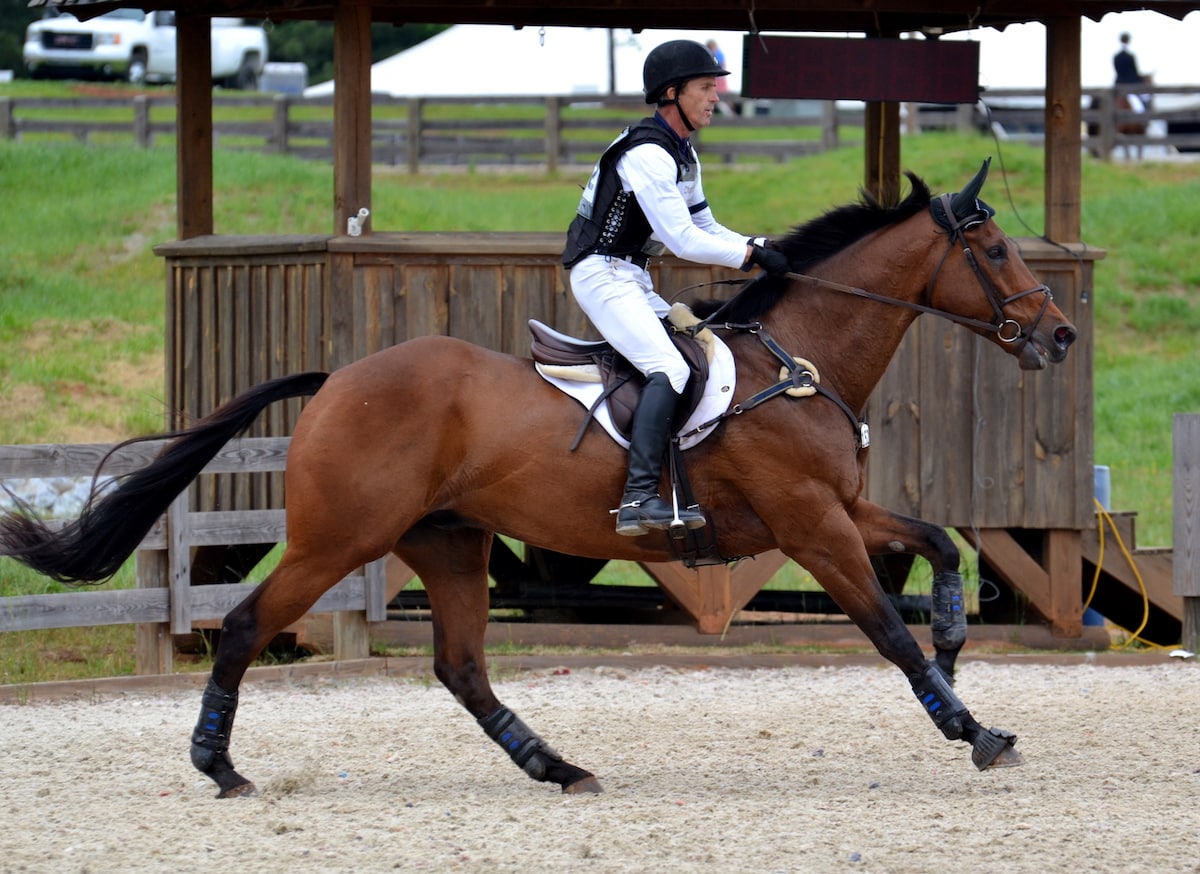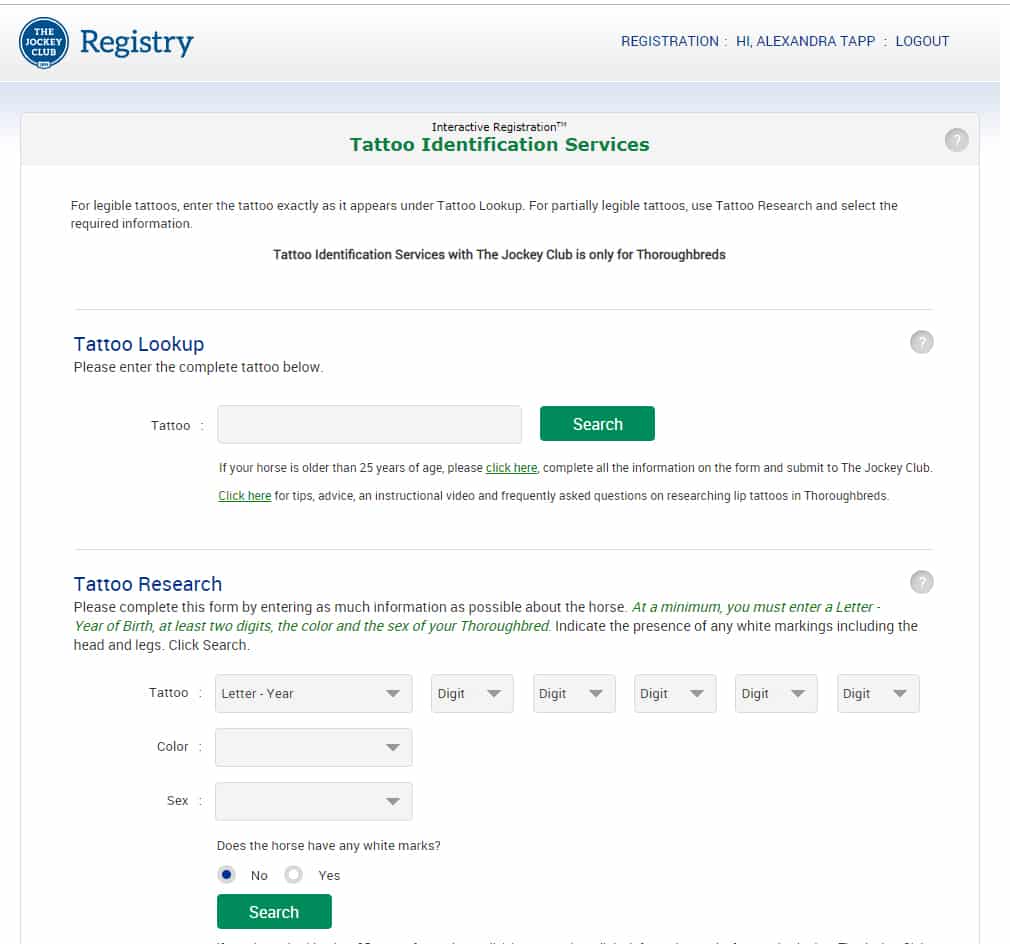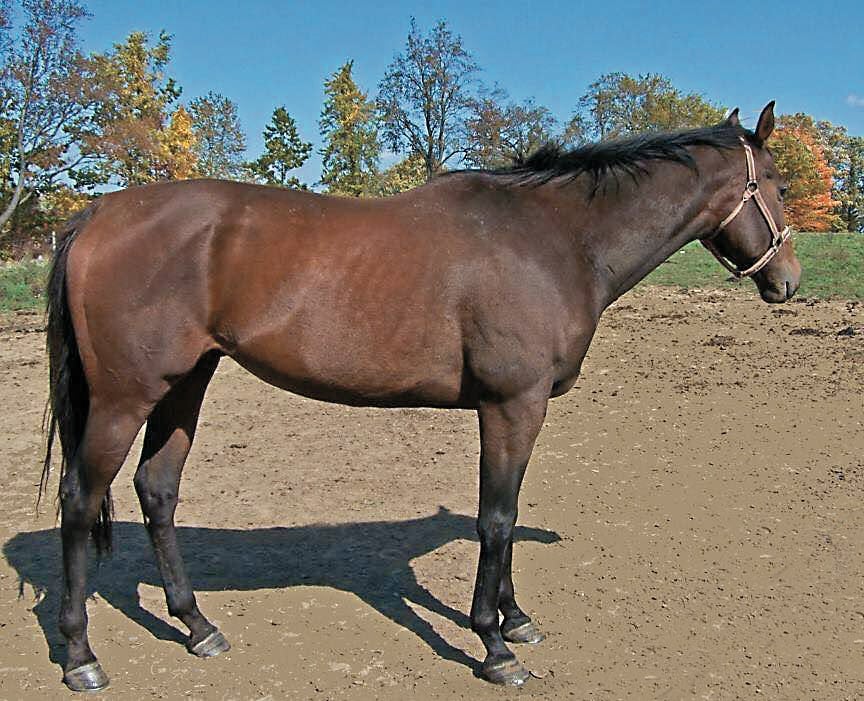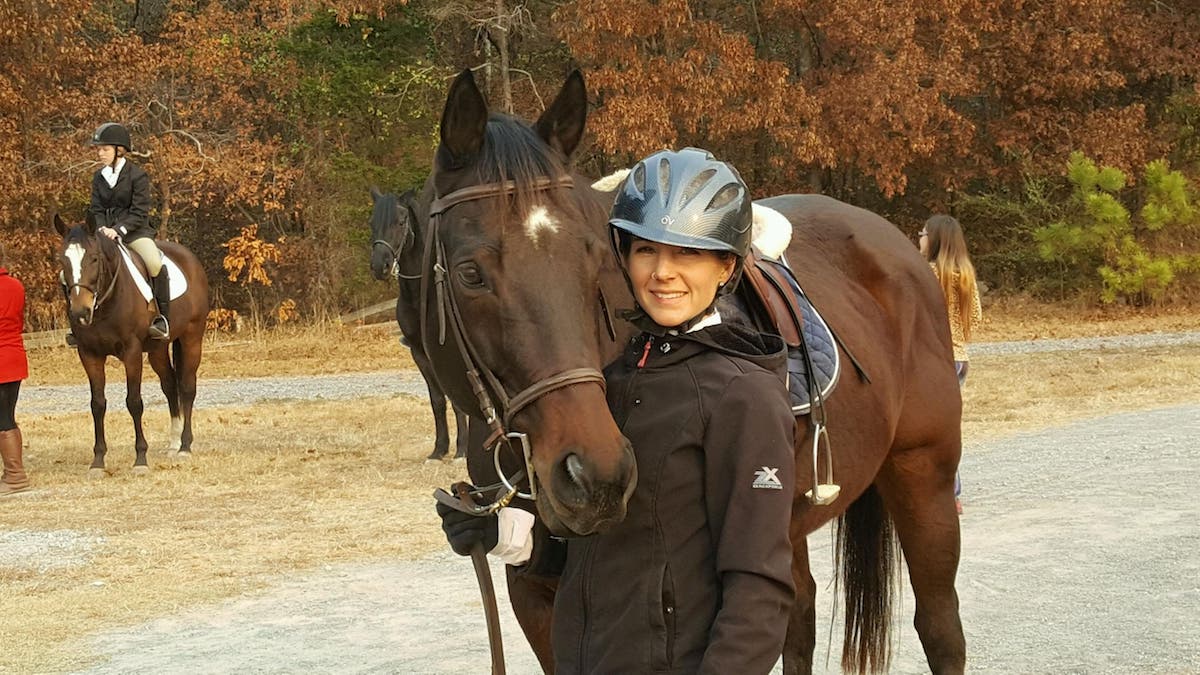Tips for identifying Thoroughbreds with unknown pasts

Rick Wallace and Ultimate Victory at the 2013 CIC*** at Chattahoochee Hills, in Georgia. He found out that the horse’s registered name with The Jockey Club is Play Nice. Rather Be Riding Photography, courtesy Rick Wallace
I’ve been lucky when it comes to knowing the identities and histories of OTTBs I’ve owned. I’m aware that Icy Edge, my eventer through high school and college, won just $1,410 in 12 starts over six months in 1984. He rose to intermediate-level eventing in the decade before he came to me, clearly preferring undulating cross-country courses to dirt track. And my current OTTB, It Happened Again, is a graded-stakes winner whose success can be tracked easily via the BloodHorse archives and Equibase. I was able to discuss his history in-depth with his racing owner, learning about her and her trainers’ philosophies on work, time off and sound retirement.
But not everyone has these luxuries, and it’s unsurprising that with as many racehorses that walk the earth, owners sometimes find themselves with a mystery to solve — a horse that’s obviously a Thoroughbred, due to the telltale tattoo beneath his or her upper lip, or a horse that’s probably one, due to location (in racing country, perhaps) and/or vague history.
Fortunately, there are ways to identify some of those OTTB John and Jane Does to find out what paths they’ve taken to our possession.
Straightforward Sleuthing
In researching this article I’ve found that unidentified OTTBs do not have known registered names due — though not limited — to a few basic reasons. The horse might or might not have raced, but he or she:
■ Has an established nonracing career, and the racing history/pedigree has gotten lost somewhere along the way;
■ Is a performance horse prospect with a similar story; or
■ Was purchased at auction without any identifying information.
Whether it’s simple curiosity, a hope to breed or a desire to compete the horse in designated retired racehorse competitions, something motivates an owner to dig into a mystery Thoroughbred’s identity.
The most obvious place to begin is a lip tattoo. The Jockey Club — the breed registry for Thoroughbreds racing in the U.S., Canada and Puerto Rico — says most state racing commission rules require horses to be lip tattooed to participate in official Thoroughbred races.
This tattoo serves as identification before a race. And if it remains legible it serves as identification in the horse’s life going forward.
The underside of a tattooed Thoroughbred’s upper lip consists of a letter, followed by four or five numbers.
Sarah VandenBerghe retrains Thoroughbred racehorses at her Cross Winds Farm, in Dryden, Michigan. She’s known the history on most of the horses she’s bought, but she’s helped other people read tattoos.
“In one instance the girl was told (by a buyer) the horse was 8,” she says, and it had been a few years since the transaction, so she expected him to be 10-12. “As soon as I looked at the tattoo, I knew right there it wasn’t 10 years old because I know the letters. That’s a nice advantage of the Thoroughbreds having the tattoos, is the letter represents the year they were born, and what most people don’t understand is the numbers represent the rest of the registration number.
“He was 18,” she adds. “But thankfully, I was able to find out who the horse was before she sold him,” so she could provide correct information on his age.
Write down what you believe the tattoo to be, and go to Registry.JockeyClub.com. You’ll be prompted to sign up for Interactive Registration (it’s free) or to log in if you already have an account. Under “Other Forms,” in the brown column on the right, click on “Research a Tattoo.” There you’ll find a Tattoo Lookup blank to use if you’re confident about the letter and digits.
Click “Search” and, almost instantly, you’ll have the horse’s registered name and information. If the age and description match, then you’ve got your horse.

A Horse in a Plain Brown Wrapper
Below the simple “Research a Tattoo” form is a more involved one, which I’ve used many times, both with and without success. Say you’re positive about the letter, but fuzzy on a few of the numbers, or vice versa. Input the figures you’re pretty sure about and select the horse’s color and sex. If the horse you’re researching is a gelding, remember that he might not have been when he was registered, so select “Horse,” too, as his gender.
Last year when working on a feature story for these pages, I was writing about a mounted police horse whom the sergeant knew was an OTTB, but whose tattoo is impossible to read. Was the leading letter a Q or an O … or possibly a P? Were those 3s or 5s?
“A lot of people just don’t supply a good enough picture,” says VandenBerghe. “The hardest thing I’ve found is if the lip is really wet. So I’ll take a towel out and dry it off.”
She uses two photo-editing programs to help her identify the horse, Corel Photo and Photoshop, enlarging the image and manipulating its brightness to help her decipher each figure.
With the police horse’s tattoo photo, I played with the brightness, contrast, and color. Still no luck.
I enlisted the help of The Jockey Club and even posted photos of the horse’s tattoo to OTTB Facebook groups, but we were never able to identify him. Known as “Freedom” around the barn, he’s a plain bay with no markings — something The Jockey Club’s registration department calls a classic “plain brown wrapper.” With these horses you usually must rely on legible tattoos and distinguishing whorls or cowlicks in the horse’s coat. When I put in what I think to be a few digits of Freedom’s tattoo, I get four or five options — some note horses with unusual whorl locations and smatterings of white hair in places on the body. Freedom? He has a few white hairs on one of his legs, but that’s probably due to a scar from an injury obtained long after registration.
VandenBerghe had better luck with one OTTB she didn’t know the ID of when she was buying. The gelding was tall, had a kind eye and was in terrible condition. He no-saled, and VandenBerghe made a $600 offer after he walked out of the ring.
“I don’t know at what point we did the tattoo research but come to find out someone had bred him in Michigan, and they actually did all the training at home — it just made sense why this horse was such a nice horse.”
After some rehabilitation and retraining, the horse — Notaquitter (Meadow Prayer — Arabian Quail, by Arabica) — has gone on to be a dressage and trail horse for an adult amateur rider and her son in Georgia.
The Jockey Club says website users like me and callers make hundreds of requests for tattoo lookups and research per year.
“We generally try to identify horses using tattoos, markings and history first,” says Lori Johnson, associate registrar for The Jockey Club, “but if the horse is not tattooed or if the tattoo number has badly faded, DNA typing might be the best option.”

Sarah VandenBerghe researched the tattoo of an OTTB she bought at a sale (shown here after rehab/retraining); he was Notaquitter, a Michigan-bred that has gone on to be a dressage and pleasure mount. Courtesy Sarah VandenBerghe
Playing Nice With DNA
The Jockey Club began requiring DNA typing for all Thoroughbred foals at registration beginning with the 2001 crop. It’s reported the process as an efficient means of identification and parentage verification testing, especially considering that sales and racetrack officials perform marketing comparisons regularly.
“When there are questions about a horse’s identity, hair samples are collected and sent to the lab for DNA testing to either confirm identity or point us to the ‘other’ horse if it is a case of switched horses,” says Johnson.
“We’ve averaged 80 DNA kits for unknown horses per year over the last several years,” says Johnson. “In addition, T.I.P. (The Jockey Club’s Thoroughbred Incentive Program) has received around 30 ID requests (in 2018), some of which are resolved through research, and others end up being DNA cases.”
The Jockey Club provides instructions on its website for DNA sampling. It involves pulling (the sample must include roots) about 50 clean, very dry mane hairs at the base of the neck, inserting them in the kit and adding postage and mailing it in a preaddressed envelope. (Learn more by hovering over the gray bar at the top of the registry page, then clicking on “DNA Sampling” beneath “Register My Foal.”)
Once the lab receives the sample, the testing is usually completed within three or four business days, she adds.
Johnson and Kristin Werner, T.I.P. coordinator and senior counsel for The Jockey Club, say they’ve used DNA multiple times to help put registered names and pedigrees with previously unidentified horses, but the following story is one of their favorites.
In 2007 Rick Wallace went to look at his eventual horse Cody at a dressage barn in Florida on daughter Elisa’s recommendation (Elisa is a four-star event rider and winner of the 2018 Thoroughbred Makeover [see page 12]). Rick Wallace wrote in a Facebook post that the horse was a 3-year-old sun-bleached bay with no distinguishing markings, and his sellers had no information on his parentage — just that he’d been race-broke and came from Ocala Stud Farm.
Rick Wallace purchased Cody as a resale project, giving him the name Ultimate Victory when a “V” in white hairs grew in on his forehead.
After selling the horse and ultimately buying him back, he used T.I.P. DNA testing to confirm in 2013 that Cody is “Play Nice,” a 2003 by Friendly Lover out of Alaskan Treasure.
He sold Cody again, but the two have reunited four-plus years later, and he and Cody’s current owner are working through his third purchase of the horse.
“We call him boomerang,” he says. “I have worked hard to get him back to upper-level condition, and we will strike off at the Ocala Jockey Club in the CCI*. … I feel he is building back, I hope to aim him for the 2019 AEC (U.S. Eventing Association’s American Eventing Championships) Advanced Championships.”
Microchip Millennium
Theoretically, identifying registered Thoroughbreds with hard-to-read tattoos will become quicker and easier with horses coming on the track in 2019. This is because The Jockey Club added microchips as a registration requirement for foals born 2017 and later.
Veterinarians (or providers under a vet’s supervision) must insert ISO 11784/11785-compliant microchips, which are about the size of a grain of rice, on the left-side nuchal ligament of Thoroughbreds (basically, the left side of the crest of the neck). This helps avoid inadvertently missing the microchip with a scanner and implanting another. You can use a scanner that can detect ISO-compliant 11784 134.2 KHz radio frequency identification devices to identify microchipped horses. These are available for purchase from companies such as Datamars at a special rate for Thoroughbred owners.
You can find more information about microchipping in that same tool I mentioned earlier, using the “Microchips Lookup, Request, & Reporting” link just below the tattoo option. There’s also information here on how to get a scanner.
“We see the microchip as a convenient additional layer of confidence when establishing the identity of a Thoroughbred,” says Johnson. “We strongly recommend that the chip number be used in conjunction with the recorded markings.”
It’s All About Connections
Lauren Wheaton, of Knoxville, Tennessee, saw a riding video of an apparent OTTB in New Jersey she liked for a lesson prospect. So, she bought him and shipped him south.
“He came to me with an approximate age, but no name or papers,” she says.
Wheaton posted photos of the bay gelding’s tattoo and facial markings to an OTTB Facebook page. “His tattoo was very hard to read, as he was 14 years old, but that’s all we had to use,” she adds.
“A group of us went through and narrowed it down until one person knew one of his old connections,” says Wheaton. “He had gone through several hands after his initial retraining, and each time money forced his sale. There was even an old YouTube video of him, which we used to identify him.”
The horse ended up being Hobnob, a 2003 Kentucky-bred by Grand Slam out of Sensual Moment, by Deposit Ticket.
“I had no idea he had been a kids’ horse already,” says Wheaton. “He came with a bit of baggage and badly rushed jumps. I showed him in hunters and 2’6” classes and trained him for a year before finding a little 9-year-old girl whose OTTB had to retire. She does cross-rails and pleasure classes on him now and adores him. He had to learn to relax again and he did. His new rider loves how easy he is and willing to do his job. Everyone asks where they got him. He takes good care of her, and she works hard to be the rider he needs.
“My tip is to reach out in the community,” says Wheaton. “Racing is a tight-knit group, and those who love the horses are usually willing to help you.
“I prefer to know a lot of background information on OTTBs especially,” she adds, “but this time my gut feeling on the horse was correct.”

Lauren Wheaton figured out Hobnob’s identity with the help of a YouTube video and Facebook connections. Courtesy Lauren Wheaton
Time Well-Spent
All said, it’s usually possible to track down an OTTB’s identity, though it might require some footwork or expense ($80 for a DNA test). But the benefits reaped from knowing the truth often outweigh any drawbacks.
“For years, I often wondered if Cody was all-Thoroughbred, and when I heard about The Jockey Club/T.I.P. DNA process, I jumped on it,” says Rick Wallace. “It was simple and fast and amazing. There is nothing more satisfying than knowing your horse’s lineage and being able to understand that even when I did not know it, my daughter and I loved this horse — which, at the end of the process, was discovered to be the immediate offspring of one of Elisa’s favorite Thoroughbred sires, Friendly Lover.”
This article was originally published in the Winter 2019 issue of Off-Track Thoroughbred Magazine, the only publication dedicated to the Thoroughbred ex-racehorse in second careers. Want four information-packed issues a year delivered to your door or your favorite digital device? Subscribe now!

